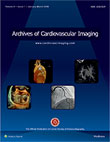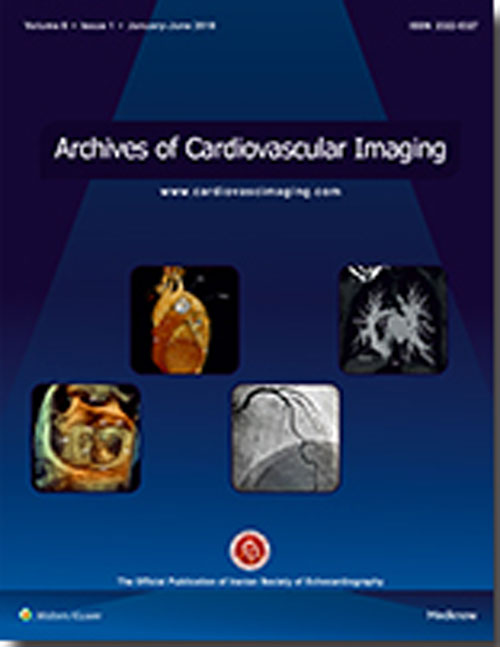فهرست مطالب

Archives Of Cardiovascular Imaging
Volume:5 Issue: 2, May 2017
- تاریخ انتشار: 1396/10/30
- تعداد عناوین: 5
-
Page 2Coronary-cameral fistulas (CCFs) constitute a rare anomaly that can be incidentally detected during angiography. CCFs are solitary, large or small assemblies that originate from coronary arteries and enter one of the cardiac chambers. We describe a 29-year-old woman, whoreferred to our clinic with the chief complaints of palpitation, atypical chest pain, and dyspnea on exertion (functional class II). Multimodality imaging confirmed the diagnosis of a CCF from the left main with extension to the right atrium and drainage therein. The CCF was closed percutaneously with a patent ductus arteriosus occluder successfully.Keywords: Coronary-CameralFistula, Coronary Anomaly, Echocardiography, Coronary Computed Tomography Angiography
-
Page 3BackgroundThe central venous catheter (CVC) is broadly used in medical practice. However, its use constitutes an invasive procedure with morbidity.ObjectivesTo assess the role of computed tomographic angiography (CTA) in CVC related complications and the mid-term outcome of dialysis patients after their treatment.MethodsThis is a retrospective analysis of prospectively collected data of dialysis patients treated for CVC-related complications and their monitoring during a midterm follow-up.ResultsFrom 2012 - 2014, eight patients (mean age 59±1.2 years; 6 males) with CVC related complication were treated. All complication were diagnosed and verified by a CTA (100%). Two patients presented with local hematoma, 3 with major bleeding, 2 with a retained guide-wire, and 1 with a disconnected part of a port-catheter. The direct repair of an arterial or venous wall injury was undertaken in 7 patients, with the simultaneous removal of a retained guide-wire in 2 and the removal of a misplaced CVC in 1 of them. One patient had the endovascular approach with the removal of the disconnected part. No death or major complication occurred during the procedures. During the follow-up (range =12 - 24 mon), no re-intervention, clinical episode of venous thromboembolism, or death was recorded.ConclusionsInvasive treatment of dialysis patients for CVC related complications is effective and durable during mid-term follow up with no re-intervention, clinical episode of VTE or death. CTA is a reliable mean for the diagnosis of CVC related complications.Keywords: Computed Tomography Angiography, Central Venous Catheters, Catheterization, Venous Thromboembolism, Injury
-
Page 4An elevated pulmonary artery pressure (PAP) from any cause is associated with increased mortality, especially in cases of primary pulmonary arterial hypertension (PAH). One of the many reasons behind a bad prognosis is the inherent difficulty in assessing right ventricular (RV) function with reproducible methods. Intensive research involving the left heart has made it relatively easy to assess left ventricular (LV) systolic and diastolic functions in many centers around the world. As for the RV, however, although increasing attention has been focused on the right-sided heart in the recent times, neither global longitudinal strain nor right ventricular ejection fraction (RVEF) has been studied well in relation to the outcome (unlike in the LV). Another issue is that the right heart functions in a circuitry involving the right atrium (RA), the RV, and the pulmonary artery. Hence, all 3 components of this circuit have important roles in unison to eject a cardiac output equivalent to the left-sided heart. In this review, we sought to discuss the ways to quantity the function of the entire circuit using both standard and advanced echocardiographic imaging modalities. As primary PAH is the classic form of pathology causing the RV to face an afterload with which it is not destined to cope, this review is mainly based on the assessment of the right heart as a circuit in idiopathic primary PAH.Keywords: PulmonaryArterialHypertension, Prognosis, Idiopathic
-
Does the post-systolic shortening of the left ventricle by tissue doppler imaging predict coronary artery disease?Page 5BackgroundAbnormalities in the velocity and pattern of myocardial shortening on tissue Doppler imaging (TDI) have been proposed to aid in the noninvasive diagnosis of coronary artery disease (CAD).ObjectivesWe investigated the diagnostic value of post-systolic shortening (PSS), a delayed ejection velocity of the myocardium after the closure of the aortic valve, on TDI in the diagnosis of CAD among patients with chest pain and normal resting wall motion on standard 2D echocardiography.MethodsEighty consecutive patients (49% female) with typical ischemic chest pain but without prior myocardial infarction, coronary revascularization, arrhythmia, or heart failure, who had no regional wall motion abnormalities on resting echocardiography revascularization, arrhythmia, or heart failure, who had no regional wall motion abnormalities on resting echocardiography at 2 levels (basal and mid left ventricle [LV]) in each of the 4 LV walls (i.e., septal, anterior, inferior, and lateral). Coronary angiography was performed and interpreted per standard clinical protocols.ResultsCompared to the patients with normal coronaries, those with angiographic CAD showed significantly increased myocardial isovolumic relaxation time (IVRT) velocity (P 4.0 m/sec, a positive PSS velocity had about 65% sensitivity and 85% specificity with a positive predictive value > 90% in predicting angiographic CAD.ConclusionsAmong patients with chest pain and normal LV wall motion on 2D echocardiography, a prominent and prolonged IVRT on TDI may help predict the presence of significant CAD.Keywords: Coronary Artery Disease, Echocardiography, Tissue Doppler Imaging, Post-Systolic Shortening


